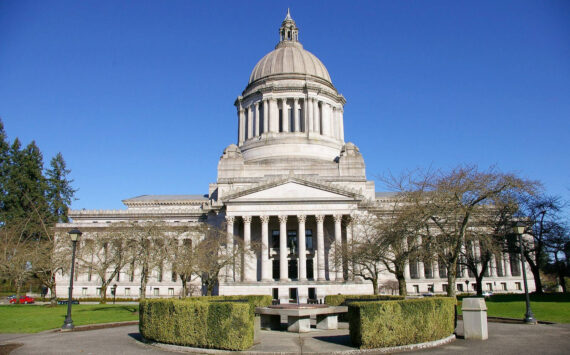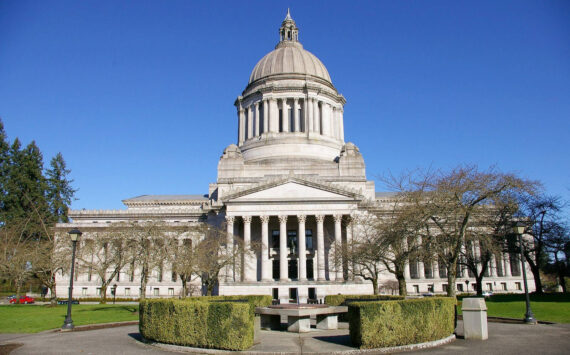For the few Winthrop residents gathered at Brick City last week to hear the latest news on the Winthrop Hotel in downtown Tacoma, the scenario was familiar: someone was considering a purchase and renovation of the 12-story, 84-year-old building that is home to 194 low-income residents and stands sentinel at the corner of Ninth and Commerce.
Tacoma Housing Authority Executive (THA) Director Michael Mirra told attendees — which included the few residents, as well as representatives from the Tacoma Police Department, Safe Streets, the City of Tacoma, and the building’s management company — he was asked by the building’s current owner if his agency is interested in purchasing and renovating the building.
If THA purchases the building, it would consider two uses:
- Address decades of deferred maintenance by fixing up the building and keeping it in its current use as affordable low-income housing. Mirra estimates the building needs tens of millions of dollars in deferred maintenance and rehabilitation.
- Or convert the building into a mixed-use property consisting of low-income housing, market-rate housing, and commercial office and retail space, and lease the ballroom to the public.
It’s not the first time someone with development ideas has circled the building — a structure built in 1925 as a luxury hotel, named after Northwest explorer Theodore Winthrop (but originally called the “Citizens Hotel of Tacoma” after a number of Tacoma residents contributed to its financing through a local subscription drive as an effort to boost the local economy), and located within the Old City Hall Historic District.
In 2005, two out-of-town developers wanted to turn the Winthrop into an historic hotel. A year later, another out-of-town developer purchased the building with plans to keep it as a home for low-income residents. Finally, in 2007, a local developer, Prium Companies, purchased the building with the intent to turn it into an historical hotel and find or build affordable housing for the tenants who would be displaced.
No developer has succeeded with their plans.
During last week’s meeting, Mirra said his agency was “looking the building over to try and tell us the condition of the building and what it would mean to own it.
“We don’t know if we can buy it,” he added. “It’s preliminary at this point. There is no agreement in place. THA has not agreed to buy the building. We haven’t determined if we can assemble the financing to buy it.”
Mirra acknowledged various viewpoints exist regarding the building’s ideal use: it should be restored as an historic hotel or other public use; it should not be used for low-income housing because it is a detraction; and it is a valuable source of affordable housing, particularly for residents with rare Housing and Urban Development subsidies, and particularly in a city where low-income affordable housing is sparse.
Still, if another developer comes forward with plans to turn it into an historic hotel, Mirra said he wouldn’t get in the way. Until then, THA will continue its due diligence.
WITH SO MUCH focus on turning the Winthrop into an historic hotel, one could wonder how the former hotel was turned into a high-rise apartment building.
One major player in that transformation was the City of Tacoma.
Thirty-six years ago, city leaders gathered to mark the grand opening of the newest downtown development project — the Winthrop as the home to 200 low-income seniors.
Visitors were given personal tours of freshly painted apartment homes. An article in the July 15, 1973 edition of the Tacoma News Tribune — “‘New Winthrop a boon to elderly'” — includes a photograph of then-mayor Gordon Johnston and then-city manager William Donaldson inside a newly remodeled apartment and peering into cupboards and a refrigerator. And the prospect of more affordable housing and a spike in business for nearby merchants held promise.
In the summer of 1973, city leaders were optimistic about the building’s affordable housing model. Spend a couple hours in the Northwest Room at the Tacoma Public Library panning through microfiche archives, and you get the sense that downtown developers meant well by converting a former hotel into high-rise housing for low-income seniors.
“I’m really pleased to see what a good job has been done to make the Winthrop useful in the community for housing,” raved Donaldson in the Tribune article. “I wouldn’t mind living in there myself. And the tenants will bring $500,000 in added purchasing power annually to assist downtown businesses.”
At the time, Tacoma-based developer Conifer Development Corp. spent $1.5 million on the renovation. Studio apartments rented for $119 per month; one-bedroom units were $154 (a rent-supplement program reduced that figure to 25 percent of an individual’s income). A waiting list existed for tenants eager to move in; before the building officially opened Aug. 10, 150 tenants (senior citizens 62 or older with assets of no more than $5,000 and on low- or fixed-incomes) qualified to move in. Apartments boasted electric baseboard heating, city views, and well-managed security. The Crystal Ballroom was a hub of social activity for residents. The building even housed an inter-faith chapel. A sign outside the Winthrop summed up the mood: A prestigious address for senior citizens.
A few years ago, I spoke with Dale Wirsing, former business reporter and editor at The News Tribune, and past president of the Tacoma Historical Society, for an article I wrote about the Winthrop over the past three decades.
“It’s just my impression, but at the time this was the best deal that the city could make to keep the Winthrop in use and have some kind of usefulness for that old building, rather than allowing it to become derelict,” Wirsing told me. “It didn’t seem the market was going to support it being used as a hotel, and Tacoma was at the bottom of the down cycle for downtown. I think people in city government thought they were striking the best bargain they could.”
City of Tacoma historic preservation officer Reuben McKnight agreed.
“Probably any use for a building like that was probably a good one,” he said. He added that in most U.S. cities by the 1970s, a lot of people moved into the suburbs, while low-income populations remained downtown. “In Seattle and Tacoma, a lot of high-rise buildings [downtown] were elderly and transitional housing because there weren’t many people remaining,” he said.
In Tacoma, several factors led to the Winthrop’s low-income housing profile 30 years ago. Tacoma Mall, which opened a decade earlier, had sucked most retail out of the central business district; a number of smaller, substandard SRO hotels downtown were demolished; and national trends in low-income affordable housing pointed to large buildings and high-rises.
“A lot of people that had been living downtown just needed a place to drift into,” preservationist and historian Michael Sullivan told me.
He pointed to two then-popular models that encouraged a concentration of high-density, low-income housing. In New York, developer Robert Moses led the charge of tearing down tenement houses and building modern, big-block buildings. In Chicago, the so-called Cabrini-Green model ruled the day. Located on Chicago’s north side, the high-rise apartment buildings housed 20,000 people. Though the goal was to create a mixed-income neighborhood, it proved controversial when the neighborhood was overrun by gang violence.
“In many communities, there were conversions like the Winthrop where hotel rooms moved to those models,” Sullivan observed. “That was the model.”
Six years after its feted opening, the Winthrop started to receive critical attention. THE GRANDE DAME STANDS JADED AND JAUNDICED screamed one headline for a column written by The News Tribune’s John Lawrence, and published May 20, 1979. Lawrence described the building as “sullied, soiled, and scarred.” His column hints at some of the trouble that would follow downtown.
Tacoma’s drug wars heated up, and by the late 1970s, it was a darker and more predatory downtown no longer comfortable to seniors
At the Winthrop, several events raised concerns.
In 1996, a woman fell down an elevator shaft to her death.
In 2002, a man reportedly jumped from a fifth floor window.
In 2006, City Manager Eric Anderson ordered the Tacoma Fire Department to inspect the building. According to a city report, inspectors found 41 corrections over a two-day period.
Also in 2006, TPD served two narcotics search warrants on Winthrop residents, resulting in the arrests of five people on a variety of charges tied to alleged illegal drug activity.
DECADES PASSED BEFORE developers started looking anew at the Winthrop.
In 2006, Oakland, Calif.-based developer AF Evans negotiated a 60-day purchase agreement with the building’s owner, Al Hanson, and planned to spend as much as $21 million to purchase and renovate the building by restoring its grand ballroom, improving commercial storefronts, and transforming 26 units into market-rate apartments. The remaining 168 units would continue to serve as federally subsidized apartments.
Meanwhile, two developers — Tim Quigg from Aberdeen, Wash., and Chester Trabucco, from Astoria, Ore. — also had development ideas. They wanted to restore the Winthrop to an historic hotel. The pair’s $40 million plan — which was laid out at early-morning meetings at a coffee shop downtown and open to anyone interested in participating — called for a new parking garage, as well as relocation costs for tenants who would be displaced by the development. At one point, AF Evans signed a letter of intent giving Quigg and Trabucco 30 days to decide whether to purchase the building. But the pair could not assemble the financing.
By year’s end, AF Evans backed out of the project and Prium stepped forward with an interest. In February 2007, AF Evans announced it had transferred ownership and management of the Winthrop to Prium. Later that year, Tacoma City Council authorized a $2 million loan to assist Prium’s goal of renovating it into a historic hotel. As part of that agreement, the city directed Prium to create replacement housing for tenants who would be displaced by development. The hotel provides 170 units of affordable, low-income housing.
For the past couple years, development activity has been quiet at the Winthrop.
That could change.
Last week, THA’s Mirra told meeting attendees his agency would make a decision on whether to purchase the building from Prium by mid-summer.


To read the Tacoma Daily Index‘s complete and comprehensive coverage of the Winthrop Hotel, click on the following links:
- A Building on the Brink: Add nuisance report, falling debris to Winthrop’s woes (Tacoma Daily Index, August 19, 2011)
- A Building on the Brink: A line-item look at Winthrop’s hefty deferred maintenance bill (Tacoma Daily Index, August 10, 2011)
- A Building on the Brink: Property report puts $15.7M price tag on Winthrop Hotel’s deferred maintenance (Tacoma Daily Index, August 9, 2011)
- Leaving The Winthrop (Tacoma Daily Index, August 17, 2010)
- 7-year prison sentence for Winthrop arsonist (Tacoma Daily Index, April 23, 2010)
- Accused Winthrop arsonist pleads guilty (Tacoma Daily Index, February 2, 2010)
- Year In Review: Winthrop Hotel (Tacoma Daily Index, December 29, 2009)
- Living On Edge: Inside the Winthrop arson investigation (Tacoma Daily Index, October 23, 2009)
- Winthrop resident accepts Safe Streets award (Tacoma Daily Index, September 16, 2009)
- Winthrop resident named Safe Streets Superstar (Tacoma Daily Index, September 10, 2009)
- Cleaning up a neighborhood, battling a building’s reputation (Tacoma Daily Index, August 25, 2009)
- Crime Stoppers offers $1,000 reward for Winthrop serial arsonist (Tacoma Daily Index, August 21, 2009)
- Historic hotel or housing? Tough economy shines realistic light on Winthrop development plan(Tacoma Daily Index, August 4, 2009)
- Winthrop history, development ideas equally storied (Tacoma Daily Index, June 4, 2009)
- Inside the Winthrop (Tacoma Daily Index, June 2, 2009)
- THA weighs Winthrop building purchase (Tacoma Daily Index, May 29, 2009)
- One dead in Winthrop Hotel fire (Tacoma Daily Index, March 25, 2008)
- Resolution would sell City-owned property for mixed-income housing (Tacoma Daily Index, October 29, 2007)
- Developer eyes City surplus property for Winthrop Hotel project (Tacoma Daily Index, September 26, 2007)
- Winthrop vote illuminates citys affordable housing concerns (Tacoma Daily Index, March 22, 2006)
- Council resolution on Winthrop rehab expected tonight (Tacoma Daily Index, March 21, 2006)
- Council may vote on whether it supports Winthrop rehabilitation plan (Tacoma Daily Index, March 20, 2006)
- Winthrop repairs mean no evacuations (Tacoma Daily Index, December 19, 2005)
In 2009, the Tacoma Daily Index published a series of interviews with many residents of the Winthrop Hotel. To read the complete series, click on the following links:
- A Voice From the Winthrop: Glenn Grigsby (Tacoma Daily Index, June 16, 2009)
- A Voice From the Winthrop: Otha Adams (Tacoma Daily Index, June 26, 2009)
- A Voice From the Winthrop: Nanette Colby (Tacoma Daily Index, July 15, 2009)
- A Voice From the Winthrop: John Heffler (Tacoma Daily Index, July 30, 2009)
- A Voice From the Winthrop: David Allen (Tacoma Daily Index, August 13, 2009)
- A Voice From the Winthrop: David Miller (Tacoma Daily Index, August 20, 2009)
- A Voice From the Winthrop: Kerry Hudson (Tacoma Daily Index, August 27, 2009)
- A Voice From the Winthrop: Jessica Creso (Tacoma Daily Index, September 1, 2009)
Todd Matthews is editor of the Tacoma Daily Index and recipient of an award for Outstanding Achievement in Media from the Washington State Department of Archaeology and Historic Preservation for his work covering historic preservation in Tacoma and Pierce County. He has earned four awards from the Society of Professional Journalists, including third-place honors for his feature article about the University of Washington’s Innocence Project; first-place honors for his feature article about Seattle’s bike messengers; third-place honors for his feature interview with Prison Legal News founder Paul Wright; and second-place honors for his feature article about whistle-blowers in Washington State. His work has also appeared in All About Jazz, City Arts Tacoma, Earshot Jazz, Homeland Security Today, Jazz Steps, Journal of the San Juans, Lynnwood-Mountlake Terrace Enterprise, Prison Legal News, Rain Taxi, Real Change, Seattle Business Monthly, Seattle magazine, Tablet, Washington CEO, Washington Law & Politics, and Washington Free Press. He is a graduate of the University of Washington and holds a bachelor’s degree in communications. His journalism is collected online at wahmee.com.







